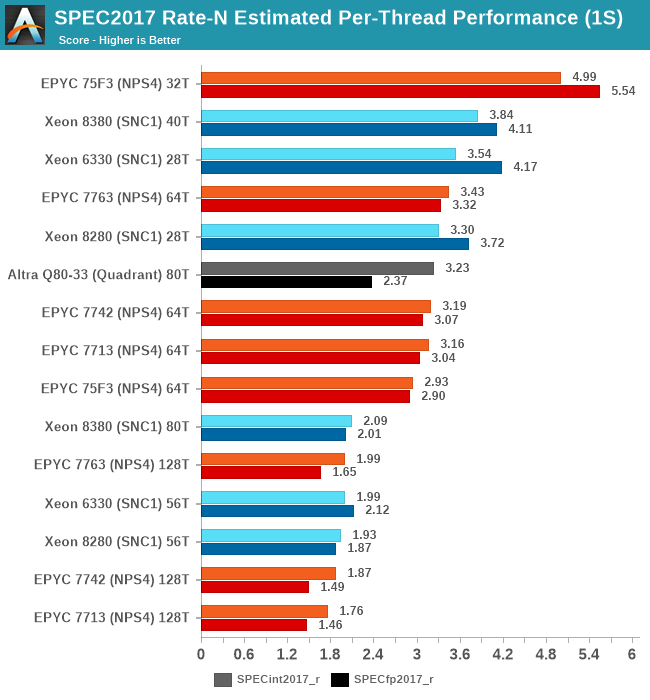Intel 3rd Gen Xeon Scalable (Ice Lake SP) Review: Generationally Big, Competitively Small
by Andrei Frumusanu on April 6, 2021 11:00 AM EST- Posted in
- Servers
- CPUs
- Intel
- Xeon
- Enterprise
- Xeon Scalable
- Ice Lake-SP
SPEC - Per-Core Performance under Load
A metric that is actually more interesting than isolated single-thread performance, is actually per-thread performance in a fully loaded system. This actually is a measurement and benchmark figure that would greatly interest enterprises and customers which are running software or workloads that are possibly licensed on a per-core basis, or simply workloads that require a certain level of per-thread service level agreement in terms of performance.
This has been a strong-point of Intel SKUs for some time now, even when the chips wouldn’t be competitive in terms of total throughput. With the new Ice Lake SPs SKUs now more notably increasing total throughput, it’ll be interesting to see the per-thread breakdown and resulting performance:

Because the total throughput generational performance increase is larger than the core count increase of the parts, this means that per-thread and per-core performance is higher with this generation. The Xeon 8380 is posting +16.3% and +10.4% per-thread performance versus the Xeon 8280 when only using one thread per core.
Interestingly, these figures are less at +8.2 and +7.4% when using both SMT threads per core. Intel has explained such an increase through the better usage of shared microarchitectural structure usage in the new Sunny Cove cores, essentially diminishing the SMT yield by improving 1/T per core performance.
Generally, Intel is extremely competitive in this benchmark metric, and while AMD easily beats them with the frequency-optimised parts, it’s an advantage that should help Intel in the SLA-centric workloads.










169 Comments
View All Comments
fanboi99 - Friday, April 9, 2021 - link
That statement is totally inaccurate. Both current gen Intel and AMD server lines are readily available.Qasar - Friday, April 9, 2021 - link
Azix, and the other part of that, could be contracts, and the prices they charge for them.lmcd - Tuesday, April 6, 2021 - link
Bunch of desktop enthusiasts failing to understand that as long as Intel provides a new part to augment an existing VM pool that isn't so awful as to justify replacing all existing systems, they're going to retain 90% of their existing customers.adelio - Wednesday, April 7, 2021 - link
but for almost every new intel line they have no choice but to replace everything anyway so AMD are not really at that much of a disadvantage, if any!Oxford Guy - Wednesday, April 7, 2021 - link
'as long as Intel provides a new part to augment an existing VM pool that isn't so awful as to justify replacing all existing systems'That's nifty. I thought Intel likes to require new motherboards and things.
I had no idea these chips are so backwards compatible with older hardware.
domih - Tuesday, April 6, 2021 - link
# Where BS == 'Marketing'AMD = 'Maximum {}, Minimum {}'.format('performance', 'BS')
INTEL = 'Maximum {}, Minimum {}'.format( 'BS', 'performance')
Foeketijn - Wednesday, April 7, 2021 - link
It's good to know powerusage is about the same as the specifications.It shows the madness of an 8 core i9 using more than an 54 core Xeon.
And even those 54 cores are not delivering a decent power/Watt.
If AMD would have made that I/O die on 7nm the this ice lake CPU would even be in deeper trouble.
yankeeDDL - Wednesday, April 7, 2021 - link
Wow. The conclusion is quite shocking. Massive improvement - still not good enough. Wow.Imagine how massively behind is the current generation compared to AMD in the server's market.
Wow.
rf-design - Wednesday, April 7, 2021 - link
The biggest sign would be if a 3nm fab in US starting hiring engaged but undervalued engineers from a 10nm fab which now found good reasons not to move to asia.mode_13h - Wednesday, April 7, 2021 - link
Andrei, thanks for the review, but please consider augmenting your memory benchmarks with something besides STREAM Triad.Particularly in light of the way that Altra benefits from their "non-temporal" optimization, it gives a false impression of the memory performance of these CPUs in typical, real-world use cases. I would suggest a benchmark that performs a mix of reads and writes of various sizes.
Another interesting benchmark to look at would be some sort of stress test involving atomic memory operations.